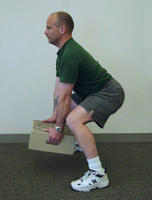College Move-in Done Right.
We have all heard it a thousand times before “bend your knees, not your back!” But how many times do we heed this advice, particularly if we are just lifting something small?
Injuries from lifting occur everyday across a variety of places from offices to warehouses to home garages and kitchens, so heeding practical tips for avoiding injury can mean the difference between a night relaxing on the sofa, and a night struggling to find a comfortable position for your aching back or shoulders.

“Bend your knees, not your back.” But what does this really mean? The back is designed to be able to bend, isn’t it? Yes, it is! But, with the added load of any sort of weight in your arms, such as a heavy box, or a child, bending over by bending the back adds undesirable stress to the discs, ligaments, and muscles in your back. You may get away with bending at your back thousands of times without any injury at all, but then one time, even when lifting a small load, you may injure your back. This injury comes not simply from the single lift you are engaged in, but from the many previous lifts where you have put strain through your back. Lifting properly each time you lift a load is crucial to remaining injury free. Bending your knees and not your back means that when you are lifting, bend down by bending at your knees, hips and ankles, and keep your back as straight as possible. As you begin to lift, hold the item as close to your core as possible, maintain the neutral position of your back and reverse the process by straightening your knees while you lift the load (avoid straightening your knees while the load is still on the ground or your back will bend). To assist your back, exhale and tighten your stomach muscles slightly as you lift by pulling in your belly button towards your spine. Keep your stomach muscles slightly engaged until you finish putting down the load. Pulling the stomach muscles in activates your core muscles around your trunk which are used to help stabilize your back while you lift. The way your core provides support to your back is likened to an internal back brace. Your Physical Therapist at Progressive Rehabilitation Associates can provide you with advanced core muscles exercises that are appropriate for you.
In cases where you are unsure of how heavy the load is that you are about to lift, such as a random box, basket or bag, it is wise to think and plan before you lift. Test the weight first before actually lifting it. If it is heavy, get help! Help can be in the form of another set of hands or a trolley (see Guide for Choosing Lifting Equipment) or a mechanical lifting apparatus. Whenever possible, spare your back from the strain of a lift or reduce the overall strain involved. An awkward load should also be negotiated with adequate assistance. Remember, every time you lift it adds stress to your body, and while with proper form this makes us stronger, the use of poor form over time can lead to injury. Also remember that there is a difference between how much you can lift, and how much you can safely lift.

Keep the load you are about to lift close into your body. The farther away the load is, the larger the force load is on your back. If you are having to lift something out of the back of a car or something that is relatively far from you (like a baby in their crib) move as close as you can to the load before lifting. You may have to put your knee or foot onto the edge of the back of the car in order to decrease the distance between you and the load. Ensure your base of support is always wide enough to provide a stable position for your body as you lift.
Once you lift the load, in order to transport it to its new location, move your feet rather than twisting your back. Twisting the spine adds load to your back as well as to your other joints such as the shoulders and hips. You may get away with twisting your back thousands of times without any injury, but each awkwardly loaded twist adds stress to the structures of the spine and gradually wears the structures down leading to the potential for injury. Also ensure you always have a good hold on the item you are lifting. An item that is slipping or falling out of your arms will add further stress to the body or may drop and cause other injuries. If necessary, put the load down and re-adjust your hold to ensure you have a good grip. Once you have a good hold, move the load smoothly to its destination. Any jerky movements or tossing of the load also adds strain to the body.
